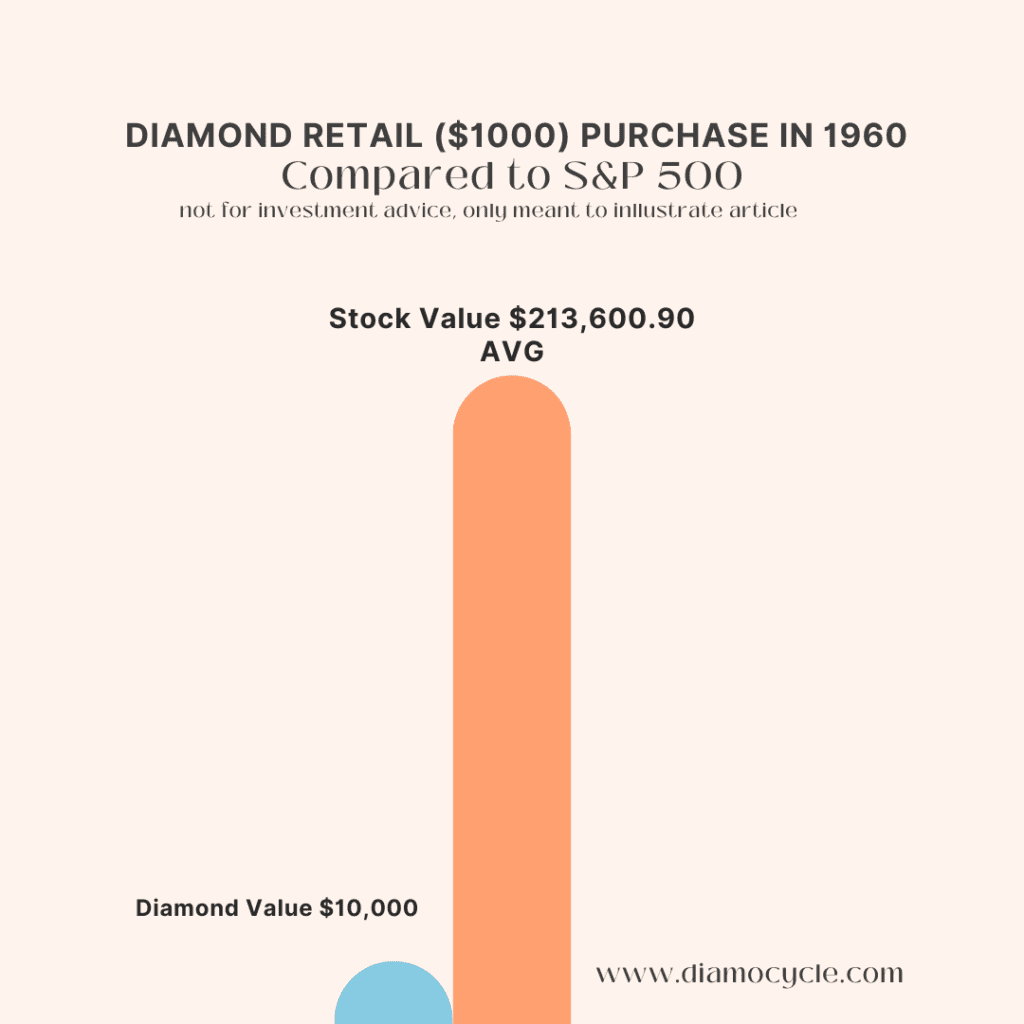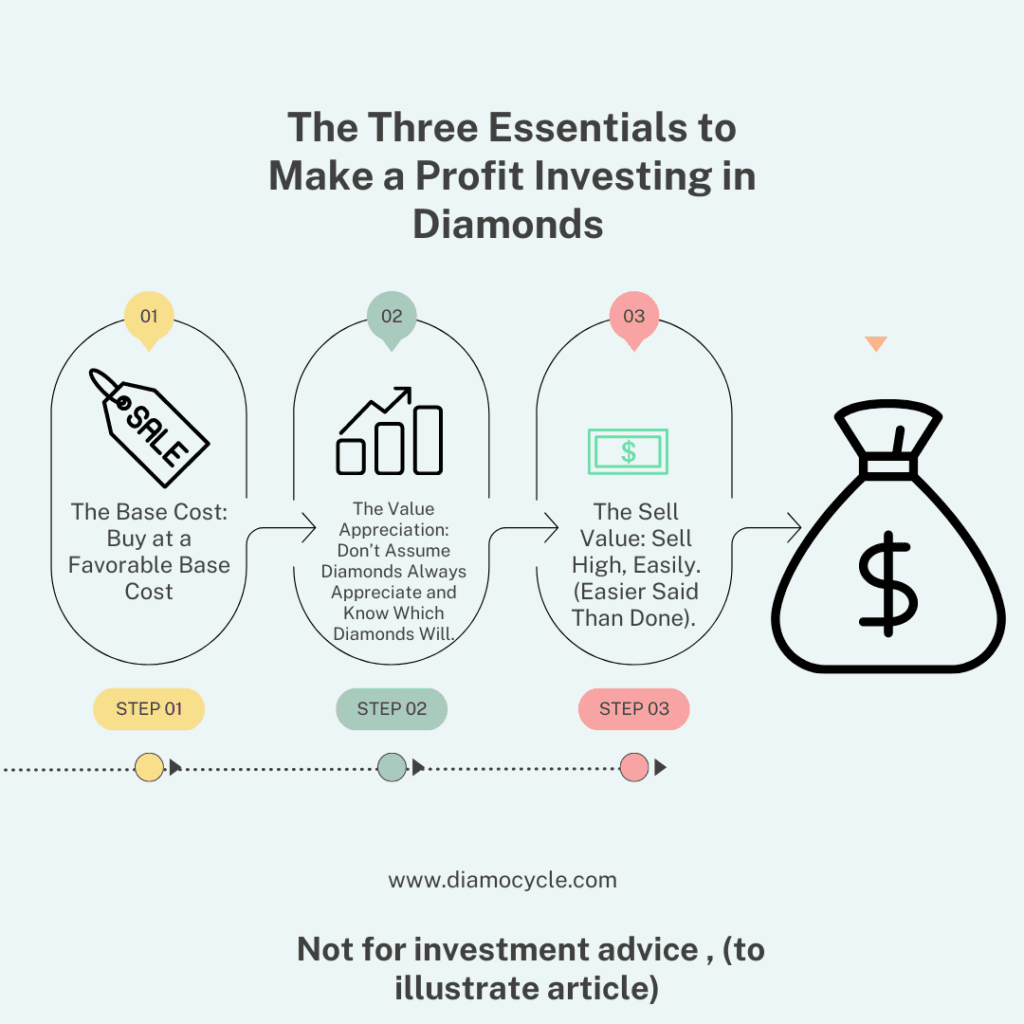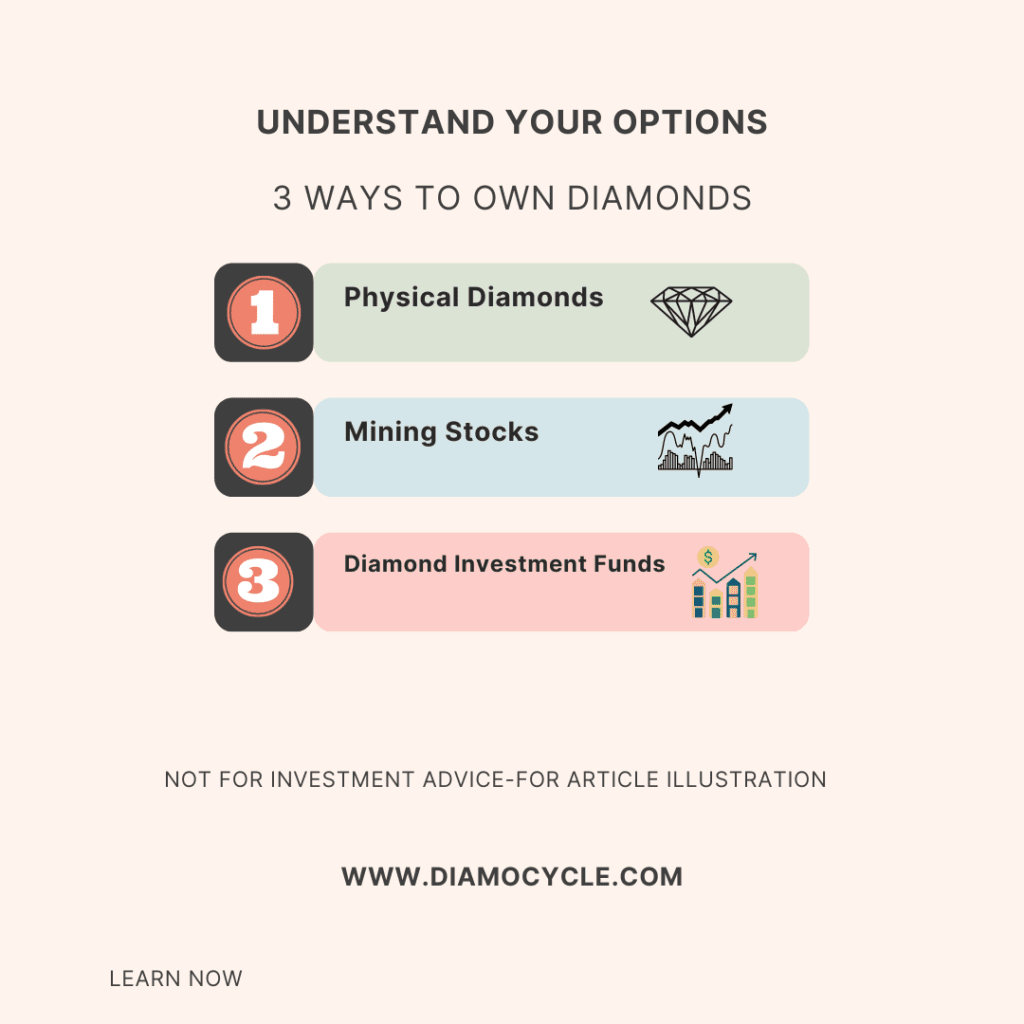Your cart is currently empty!
As well you know, diamonds mean many things to many people. Declarations of love, signifiers of family fortunes, and often, to many, strong investments. You may be wondering are diamonds a good investment? While many articles have been published and written on how to buy diamonds, there is scant literature on the investment range of diamonds as a wealth management strategy, and how to later sell investment diamonds to make a profit. As leading professionals in the diamond field, we’re proud to offer you our Diamocycle Guide on Selling Investment Diamonds.
What is an Investment Diamond?
You may be wondering, are diamonds a good investment today and the future? As the name might suggest, an Investment Diamond is a loose diamond purchased with the sole purpose of serving as an investment, or a piece of capital that will appreciate over time, allowing it to be sold for a value greater than it was purchased.
In the realm of diamonds, Investment Diamonds are loose diamonds with a color grading in the range of D, E, and F and with a clarity rating of VVS to Flawless. That said, technically speaking, like anything, if you can buy a diamond at one price and sell that investment diamond at more, it’s a profitable investment. While that may be true, diamond investing can be complicated and risky. Like any investment, we encourage you to educate yourself thoroughly in what to look for when selling diamonds to a broker and how best to invest before investing to ensure you are making the best decisions for you and your capital.
Why Invest in Diamonds?
At base level, loose diamonds as an asset class are reliable.
Diamonds often serve as a low-volatility hedge against inflation.
According to a 2014 Diamond Report from Bain & Co., diamond prices are three times less volatile than silver prices, 2 times less volatile than iron ore prices, and 1.5 times less volatile than gold prices.
Similarly, Diamond Prices often have a low or negative correlation to the NASDAQ.
Which is to say, when the NASDAQ is trending down, Diamond prices are often increasing slightly and/or holding steady. The chart below demonstrates a retail diamond purchase vs the S&P 500. The retail purchases of a diamond can not be confused with a purchase by a diamond trader or professional investor.
Lastly, in the basic economics of supply and demand, diamonds are a solid bet.
The global supply of rough diamonds is expected to decline 1.8% a year until 2024 due to the aging of existing mines and a limited availability of new mine projects. In contrast, global demand for diamonds will increase 4-5%, due to the appetites of a growing Chinese and Indian middle class, who are hungry for private consumption following the trends of Western culture, which includes fine jewelry and diamonds. Given the continued growth in demand and decrease in supply, a diamond investment will retain and rise in value.
Beyond the economic assurity of investment diamonds, there are also external (and personal) factors that help make diamond investments a worthy investment.
Diamonds often serve as a Post-Relationship Insurance.
Some recipients of diamond or engagement rings consider the stone as security or “running away assets,” should a relationship go south. As stones are rarely returned if the relationship ends, this is a practical (albeit cynical) way to insure a relationship or the ability to have a little capital to sell as an investment diamond should a relationship go south.
Larger Stones Have Larger Investment Potential.
A $100,000 diamond ring has more investment potential than a $1,000 ring. Much like real estate, as the value goes up, the seller’s margins come down, allowing the seller to potentially make more of a profit on the trade or sale of a private diamond. If you’re looking to invest in a stone of considerable size, it may change the calculations of your diamond investment considerably.
Not All Banks are Trustworthy.
Not all countries and cultures have a completely trustworthy banking system. With that in mind, many cultures and countries encourage their wealthy to maintain at least 10% of their wealth as “portable.” For example, selling investment diamonds and gold to private brokers allowed many Chinese citizens to escape from Indonesia in 1997. Depending on your cultural context, investing in diamonds to sell may be a smart and critical investment in specific moments.
How to Make a Profit Selling Investment Diamonds
To state the obvious, you’ll make a profit on your investment diamond when the value of the diamond rises and you are able to easily sell your loose investment diamond with low sales costs at a higher value than the base cost. This model of making a profit on diamonds assumes a strong appreciation in value and a low barrier to selling at a higher cost. Holding these elements as the essentials to selling an investment diamond to a broker or trader. Let’s look at each variable independently.
The Three Essentials to Make a Profit Investing in Diamonds
-
The Base Cost: Buy at a Favorable Base Cost
You may be wondering how do i value investment diamond? If you’re planning to purchase your investment diamond from a middle-man such as a diamond broker or jeweler, you’re likely to be a significant mark-up on the stone. As we’ve mentioned, this markup helps the diamond broker recoup their own investment and make a profit on the stone. With that in mind, the addition of the broker mark-up on the diamond will make it significantly harder for you to make a profit on the purchased stone as the value of the diamond will have to appreciate significantly to cover both the value of the diamond and the markup you paid.
-
The Value Appreciation: Don’t Assume Diamonds Always Appreciate and Know Which Diamonds Will.
Here are some factors to keep in mind to temper your assumption that diamonds always appreciate in value.
Changing Styles
While diamonds may increase in sentimental value over time, there’s no guarantee that they will increase in fiscal value. Decades-old diamonds often have outdated cuts and proportions that are not as marketable as compared to modern diamonds which have been developed with updated industry proportions. As diamond technology is always improving, antique cuts and proportions may actually hinder your attempt to make a profit on the sale of an older investment diamond.
The Diamond Market Itself
Diamond prices have historically appreciated over the last 25 years, but at widely different percentage diamond investment returns based on the stone’s fundamental attributes. Assuming a comparable cut, color, and clarity – a larger carat investment diamond commands a significantly higher price. Similarly, the price per carat of selling an investment diamond to a broker increases significantly with a higher color and clarity combination.
-
The Sell Value: Sell High, Easily. (Easier Said Than Done).
As we’ve discussed, it’s not always a given that you’ll be able to sell your investment diamond and make a profit on it. The biggest challenge to you will be finding a broker or trader who wants to buy your diamond (and usually only for the stone), who also trusts you and is willing to pay the price you’re hoping to command. In comparison to a buyer buying from a store, you as an individual offer less trust, no flexibility in selection, and no additional services (sizing, appraisal, insurance), which makes your sale a challenging one. Often that challenge is met with the broker or trader offering a reduced rate, which again, makes recouping the amount on your investment challenging. Not an easy feat, but it can be done!
Check out our Diamocycle Guides on Selling Your Diamond to learn more.
Say you’re still hungry to acquire or sell an investment diamond. If so, here are a few diamond investing tips to keep in mind as you go forward with your desire to invest.
Understand Your Investment Options
While most of this article assumes that you’re purchasing the physical diamond itself, we want to highlight some other ways you can invest in diamonds along with the pitfalls of diamond investing yourself.
The various ways you can invest in diamonds are by buying physical diamonds, investing in mining stocks, or putting capital into an investment fund.
If you’re investing in Physical Diamonds, we encourage you to:
Understand the Diamond Business Model
Consumers often purchase diamonds expecting their stones to appreciate in price. While diamond prices do increase, most dealers, diamond investment groups, and retailers overinflate the cost of purchasing a diamond to cover retail and business costs, making it hard for individual consumers to recoup a profit when selling an investment diamond to a broker. Beyond that, individual investors are often not equipped to sell their stone for maximum profit, given the insularity and complexities of the diamond industry.
Understand the Market
Rarer diamonds are actually harder to sell. Medium quality diamonds (with no visible discolorations or obvious imperfections) are actually easier to sell, as there are more people who might buy them.
In addition, there’s currently a shortage of freshly mined rough material in larger sizes. Due to the scarcity of rough diamonds, most private diamond traders are always looking for larger stones in traditional or modern cuts of a good quality.
Avoid Fads
While Princess cuts are hot right now, they will shortly be passé. Likewise, other unique shapes like Hearts and Marquise are also passing fads. Instead, we encourage you to invest in round brilliant cut diamonds, as they have the longest staying power and will command the most consistent price across the years when you finally decide to sell your investment diamond.
Likewise, pay attention to the color of your diamond. While pink color diamonds are currently in vogue, their rarity and relative newness may also make them harder to resell in a handful of years.
Prioritize Cuts
Pay attention to the cut of your investment diamond. 90% of round diamonds are poorly cut. Wise buyers buy non-traditional “Ideal Cut” diamonds that will fit into the new GIA and AGS best cut standards and offer you a greater potential for making your money back in the long-term when you sell your investment diamond.
Mining Stocks
With all of this in mind, mining stocks are another way to benefit from the projected lack of supply vs demand in terms of rough diamonds. That said, your return on investment is heavily dependent on the quality of the individual mine in which you’re investing. If you’re looking to invest in a diamond-related fund, we strongly recommend you examine a diversified fund of physical diamonds, as mining stocks are completely reliant on the follies and fortunes of one individual mine.
Diamond Investment Funds
In our estimation, a diamond investment fund is the best way to safeguard your investment and turn a profit while investing in diamonds. A diamond investment fund provides liquidity and a diversified portfolio. That said, each diamond investment fund is unique and must be evaluated on an individual basis. Some diamond investing funds deal strictly with diamonds of a certain size, color, or finishing.
We strongly recommend investing in a diverse fund to prevent overexposure to any portion of the market. Our favorite funds invest in a range of white diamonds in the 1.00 to 5.5 carat range, given the lasting demand and popularity of round diamonds in this size and color. Lastly, diamond investment funds can offer a strategic hedge to existing investments and a diversified portfolio can limit the downsides over-investing in one segment of the market.
As always, if you ever have any questions about investing in diamonds or any other steps of the diamond selling process – never hesitate to contact us.
Your Neighborhood Jeweler,
Diamocycle
Disclaimer: This article is for educational purposes only and does not constitute investment advice please consult an investment professional before making investment decisions. Diamonds are a risky asset class and should be only purchased by knowledgeable investors who are accredited and can afford to lose all or a portion of their investment.




